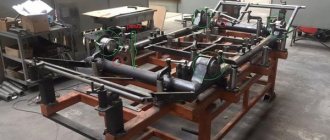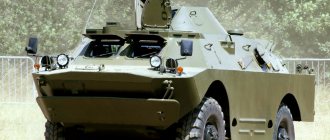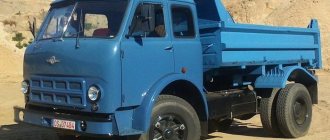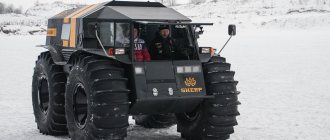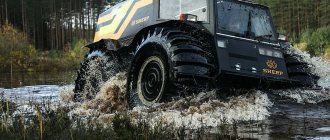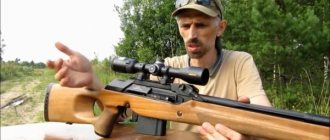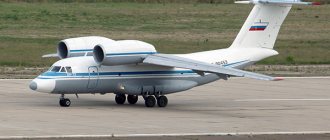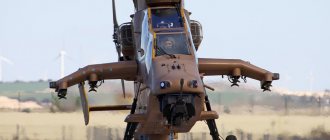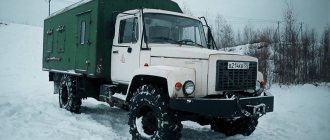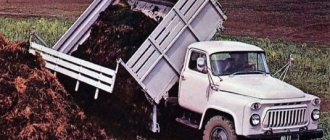Where to buy and how much it costs
A dealer network has been deployed across Russia, covering so far only certain regions: Irkutsk, Murmansk, Tver, Tyumen regions, Khanty-Mansi Autonomous Okrug and Yakutia.
In addition, there are representatives and authorized dealers in Ukraine, Kazakhstan, the USA and Canada. Trailer for transportation "Sherpa" - one of the additional options
As options for an additional fee, it is proposed to install LED headlights on the all-terrain vehicle, an additional generator, 90-watt LED headlights and mount fuel tanks in the wheels. In addition, certain benefits are offered to buyers of a trailer designed to transport Sherpa.
Author of the article:
Roev Oleg
Modifications
The Sherpa all-terrain vehicle is available in several modifications:
- Sherpa.
The standard package includes: a soft awning, wheel caps, ultra-resistant polymer body paint, three batteries, halogen optics, heat and sound insulation for the engine compartment. - Sherpa.
Kung The package includes a hard kung, which can be transformed, if necessary, into a warm soft interior. The rigid kung provides better thermal insulation of the interior. - Sherp PRO
Updated model with a lightweight aluminum body. The body is painted in an aggressive paint color (either khaki or orange-black). - Sherp PICKUP
Model with a pickup-type body layout.
The manufacturing company offers additional options for the all-terrain vehicle, which you can purchase for an additional fee, these include:
- Trailer for transporting all-terrain vehicles over long distances
- Four additional fuel tanks mounted on rims
- Generator 60A
- LED headlight kit
What does the all-terrain vehicle look like from the inside?
The Russian snow and swamp-going vehicle has impressive dimensions, can carry up to 1000 kg of weight, while the inside is as unusual as the outside:
- the cabin accommodates two seats: one for the driver, the other for the passenger. There is nothing unusual about the seats; they are the most ordinary, with seat belts.
- the rear platform is designed for transporting cargo and passengers. It can comfortably accommodate 6 adults with luggage.
- You can get inside through the door, but it is not on the side, like all cars. The cabin can be accessed through a ramp door located above the passenger seat. The rear of the all-terrain vehicle is accessed through a hinged rear hatch.
The tightness of the body allows the all-terrain vehicle to overcome water boundaries, this happens due to the rotation of the wheels. The displacement of each wheel is about 850 liters; if you take the entire unit, you get 3400 liters in total.
Body and interior
The all-terrain vehicle has a steel monocoque body. The manufacturer releases an updated Sherp PRO model with an aluminum body.
Externally, the Sherpa all-terrain vehicle seems quite small, but this impression is wrong. For a one-day trip, the all-terrain vehicle can accommodate 6 passengers. If you are planning a multi-day trip with an overnight stay in the cabin of an all-terrain vehicle, then it can accommodate two adults, and if you have a sleeping bag or an air mattress, three people can easily sleep in the cabin, and if in very spartan conditions, then all five people.
To store cargo, there are lockable compartments in the floor; for example, provisions can be stored here. There are hooks and pockets on the walls of the cabin; it is convenient to store weapons, fishing rods, and various tools here. An interesting feature of the Sherpa all-terrain vehicle is the ability to carry out almost any repair directly from the cabin; to do this, it is enough to open the niches through which access to the engine and chassis is provided.
The all-terrain vehicle does not have the usual doors; in order to get inside, you need to fold down the windshield. In the front of the all-terrain vehicle there are two seats: for the driver and the front passenger.
At the rear of the all-terrain vehicle there is a comfortable interior, in which there are two side beds on which you can sit, or you can lie down at full height. There is a tailgate at the rear of the all-terrain vehicle.
Peaceful tank
“I use the onboard drive according to the simplest scheme,” says Alexey Garagashyan, “with a large KAMAZ differential between the sides. From the differential come shafts on which ventilated brake discs with a diameter of 315 mm are installed. From the shafts there is a chain drive to the wheel hubs. Control is carried out using the gas and clutch pedals, as well as two brake levers. The advantage of this design is high maneuverability (all-terrain vehicles with steering have a very large turning radius), relatively low weight, and overall simplicity of design.
The disadvantage is that when steering you need to slow down one side. This wastes engine energy and heats up the brakes. Accordingly, you need a very high-torque engine, and even with a good diesel engine you have to switch to a gear or two lower in order to turn sharply enough.” One of the most interesting features of this side-swivel “Cheburator” is the lack of suspension. Or, more correctly, a mechanical suspension. Instead, a pneumocirculatory suspension is used (this is the designer’s own term). Its essence is that all four wheels are connected by an air line with a large cross-section - 45 mm. Therefore, when hitting an obstacle, air flows very quickly inside the system and the pressure in all wheels is equalized.
When hitting a large stone or stump, the wheel is deformed almost to the disc, but the car does not lose contact with the ground. But if there was nowhere to “vent” the excess pressure from the compressed wheel, the car would simply hang out. The suspension, which essentially consists of wheels and an air line, provides a soft, shock-free ride, but... at low speeds. When driving faster, the lack of shock absorbers, of course, has an impact. By the way, the wide air line also serves to quickly inflate or deflate tires - these processes can be controlled from the cabin. Pumping is carried out using the exhaust of a diesel engine, which, contrary to popular belief, does not corrode rubber at all.
Designer: Denis Globin. The funny name “mymyklovoz” comes from the Internet nickname of Denis Globin. A car can easily run over a person, and he will remain safe and sound: thanks to low tire pressure, the weight of the all-terrain vehicle is distributed over the huge contact patches of the wheels.
Design features and design
Some may call the design of the all-terrain vehicle futuristic, some may call it a kind of “box on four huge wheels,” but, as mentioned above, the designers did not focus on appearance, but on its capabilities in off-road conditions. This is facilitated by special low-pressure tires with transverse lugs, which easily move the car on various surfaces: snow, swamp, water, and also help overcome obstacles up to 70 cm high.
To successfully overcome water obstacles, the car body is made hermetically sealed. In tandem with huge wheels (which act as water propulsion), such a body turns the structure into a boat, the speed of which is not too high (up to 6 km/h), but, nevertheless, allows you to overcome any water obstacles and makes the all-terrain vehicle a universal means of transportation .
It was possible to achieve enviable maneuverability thanks to an unusual bot turning scheme, which is used mainly only on tracked vehicles. By locking the wheels on one side, the all-terrain vehicle can turn around almost “on the spot,” and this ability is very valuable in the taiga (and not only).
The “entrance” to the cabin is also surprising; it is through the front door. At first this does not seem very convenient, but over time you get used to it, and sometimes this is the only opportunity to leave the cabin.
The Sherpa frame is welded from pipes with a diameter of 108 mm and, in addition to the load-bearing function, has another application. It serves as a kind of wheel air duct through which all wheels are pumped with exhaust gases. The designers have achieved amazing results: it takes about 30 seconds to inflate the wheels.
The design of the Sherp all-terrain vehicle is designed for operation in extreme conditions, so its creators tried to apply the best and proven developments used in domestic equipment, especially military ones. Gagashyan placed his main emphasis on reliability and practicality. Where else if not in military technology can such solutions be found?
Advantages and disadvantages
The Sherpa SUV, due to the originality of its design and unique characteristics, still has no completely comparable analogues in the world. Among its advantages, experts and owners unanimously include:
- Maximum degree of cross-country ability;
- Highest maneuverability;
- Sufficiently high speed of movement;
- Smooth ride;
- Possibility of free exit from the water to the shore or ice surface;
- Wheels that prevent the adhesion of dirt, snow and ice;
- High reliability of the design;
- Convenient access to main technical units;
- Volumetric internal space, allowing you to freely accommodate up to 4-6 people;
- A successful climate system that provides efficient heating and ventilation.
Among the design flaws are noted:
- Low engine life (maintenance required after 50 operating hours);
- Lack of side doors in the front compartment;
- Poor reliability of circuits.
The issue of the cost of an all-terrain vehicle and components is often considered by Russians to be the main “disadvantages” of the model. Although the reason for this lies, rather, in the low general standard of living in the country. After all, publications in developed Western countries, on the contrary, emphasize the price of the Sherp all-terrain vehicle, given its characteristics, as very affordable and consider it one of the most important advantages.
Introducing the new SHERP all-terrain vehicle
New model Sherp MAX
Yesterday in Velyaminovo a new model of the Sherp all-terrain vehicle - SHERP MAX - was presented. The main differences that are immediately noticeable are that the all-terrain vehicle has become much more convenient for the driver and passengers. The dimensions have increased, the ergonomics of the driver's seat have changed, and entry and exit from the all-terrain vehicle has been significantly simplified. A third berth was added and the engine ventilation system was significantly changed, which had a positive effect on comfort in the cabin and kung. These and many other changes have made SHERP MAX more comfortable and reliable. The pricing policy remained unchanged, the price of an all-terrain vehicle in the basic configuration is 6.5 million rubles.
Price
The prices for that device are quite high, but they are still lower than those of foreign options. For the “Standard” package, you will have to pay 3,850,000. In this option, you will have a tent roof, which of course is not very good, but this solution allows you to reduce the minimum price.
You will also have halogen optics installed. With this light you can always move in the dark. You will also receive sound insulation in the engine compartment. This will reduce the noise level in the cabin, making your trips more comfortable.
For the Kung package, you will have to pay 4,100,000 rubles. In this option you will already have a hard roof. This salt will be much warmer than in the first option.
Amphibious all-terrain vehicle
The main feature of the Sherpa is that it is able to move on water. Its swimming speed is not too fast - only 6 km/h. However, this is quite enough to overcome the ford. The machine handles well in water due to the fact that the speed of rotation of the wheels on the left and right can be adjusted using levers. This feature will greatly help tourists traveling to remote places.
As you know, it is easiest to go along rivers - there is no need to wade through the forest jungle, and the route of movement can be relatively easily measured and determined on the map, simply by looking at the river bed. However, while moving, you often have to face the fact that it is impossible to move along the bank, or you have to cross the river to the other bank. It is comfortable to travel by water transport in such places only downstream. Sherpa remains. With its help, you can either walk along the river bank or cross it without preparation. And even if the all-terrain vehicle is carried away by the current, the driver always has the opportunity to correct his position in the water and get to the desired point.
Through swamps and ice
Of course, what interests fishermen and hunters most is the ability to drive an all-terrain vehicle through wetlands. We can say with confidence that he is able to go where even a person cannot go. Its pressure on the ground can be eased by lowering the tires, and it will easily pass through the swaying quagmire. He will do the same on thin ice - a thickness of 4-5 cm is enough for his movement. Many swamps in winter do not freeze at all due to biological processes, and it will be impossible to pass there without a Sherpa.
This all-terrain vehicle is capable of not only swimming in an ice hole, but also getting out of it. By adjusting the torque on the wheels, their pumping, and rotation speed, you can climb onto thin ice without breaking it. If this fails, you can simply break it down to the area where it is thicker and accomplish your plan. A real mini icebreaker!
The author of the article loves to go pike fishing in winter. This happens in one swamp. In summer the banks are muddy and it is very difficult to get to the water. But in winter it freezes, and you can catch good pike on the balancer and girders. You can fish on such an all-terrain vehicle both in winter and summer. The places there are very quiet, secluded, and relaxation is a pleasure. Happy owners of such a car can afford it at any time of the year.
Application
The Sherpa all-terrain vehicle can be extremely useful for hunters and fishermen who want to get into places where there are no other people. It is thanks to such people that the all-terrain vehicle so quickly went from drawings to serial production, and it is this category of users that ensures the ever-growing demand for it.
The all-terrain vehicle can be useful for geologists, oil and gas workers who have to move through difficult terrain and solve their production problems there.
The excellent driving performance and cross-country ability were also appreciated by law enforcement agencies. The low speed of the Sherpa all-terrain vehicle does not allow it to be used for solving operational tasks, but thanks to its good range, high reliability of the engine and chassis, the all-terrain vehicle can be used to deliver goods in difficult climatic conditions.
Suspension
An interesting feature of the Sherpa all-terrain vehicle is its pneumatic circulation suspension. All all-terrain vehicle tires are interconnected by air channels, the cross-section of which can be adjusted in a wide range (up to complete closure).
When a regular tire hits an obstacle, the tire begins to deform, the pressure in it reaches extremely critical values, which can lead to its failure. When a tire with air circulation suspension hits an obstacle, the air from this tire will flow through the air channels into other tires, thus the pressure will be evenly distributed over the remaining wheels.
It is the pneumatic circulation suspension that allows the Sherpa all-terrain vehicle not only to drive on uneven surfaces, but also to carefully roll over stones and tree trunks up to 1 meter high, and also move on a side slope of up to 35 degrees.
Device
A rather important point is that the Russian all-terrain vehicle “Sherp” received its own distinctive features and a recognizable face. Thanks to special design approaches, it is also technically advanced. Garagashyan, for example, especially highlights the design features of wheels. He created them based on his vast experience in off-road driving, using technologies that he patented.
Firstly, the Sherpas have very large wheels. They reach 1.6 m in diameter and 60 cm in width.
The wheel tread has a special pattern - it is a transverse ridge that improves movement through water and mud.
This approach is rarely used, but is really good for an all-terrain vehicle. True, we had to sacrifice the fact that the Sherpa seriously wears out the tires when driving on asphalt. The manufacturer does not recommend driving the all-terrain vehicle a lot on hard surfaces
Snow and swamp-going vehicle Sherp: instruction manual
Operation of the Sherpa all-terrain vehicle is quite simple; this type of equipment can be used to move on any type of land and water. The characteristics are achieved due to the large size of the wheels, which do not have cameras and have low pressure inside.
The Sherpa snow and swamp-going vehicle has an unusual instruction manual; you definitely won’t be able to drive it like a regular car. The wheels of the unit do not turn at all, but movement is accomplished through friction clutches, which the chief designer borrowed from the GAZ-71. In addition, the wheels have a centralized inflation system; their own exhaust gases are used to maintain the required pressure. By adjusting the tire pressure, the cross-country ability also changes, the wheels adapt to certain environmental conditions.
Distinctive features:
- patented tires and wheel inflation system;
- ease of entry from the ice into the water and back;
- turning with clutches and reliable brakes;
- a feature of the fuel system that, under any conditions, prevents fuel starvation;
- high carrying capacity both on land and on water.
Such a miracle of technology began to be developed back in 2012; this idea came to the mind of our domestic designer Alexei Garagoshyan. Together with his team, he reworked the drawings several times, looked for the optimal ratio of many components, and persistently refined the non-standard tire design.
Application
The Sherpa snow and swamp-going vehicle is an ideal vehicle for hunters or fishermen. Hunters can use it to climb into the most impenetrable forest thickets; when duck hunting, they can “visit” any impassable swamps where no human has ever set foot.
Sleeping places in the kung and autonomous heaters allow you to spend the night right in the taiga, and the windshield that opens forward and upward allows you to organize hunting “rooms” right in the cabin, especially if the Sherp SUV is painted “to match camouflage.”
In addition to lovers of hunting and fishing, the car will be of interest to many government agencies, for example: geological exploration, the Ministry of Emergency Situations, medical services, etc. With the help of such equipment, any of these services can easily reach any point where previously they could only be reached by helicopter.
And, of course, designers are counting heavily on military orders, because we are accustomed to the fact that our military equipment has always been the standard of practicality and reliability, and the Russian Sherp all-terrain vehicle is their embodiment.
How to catch on the ice?
To get acquainted with snow and swamp-going vehicles from St. Petersburg, we came to the Northern capital twice - both times in the spring, which came after a memorable snowy winter. We wanted to catch the most “all-terrain” nature with mud, deep snow, thin, crumbling ice. Now that this nature is approaching us again along with autumn, it’s time to tell you what cars that don’t care where they go look like and what they’re made of. Well, or almost anyway.
“The main feature of such cars is the wheels,” explains Alexey Garagashyan. — An all-terrain vehicle first of all consists of wheels, and then we can talk about the engine, transmission and chassis. The larger the wheels, the greater the cross-country ability of the all-terrain vehicle, the better it floats. With large tires, it acquires properties not available to other vehicles. For example, it can come out of the water onto the ice. I don’t know of any tracked vehicles that can do this.”
The car is equipped with a Japanese Kubota 1.5 liter turbodiesel. The motor has a low weight (114 kg) and a power of about 44 hp. torque 120 Nm. A separate important detail is the absence of an electronic control unit, which increases the reliability of the engine when operating in water environments. The car has two sleeping places, a trunk capacity of 600 liters. Fuel consumption on a hike is 30 liters. per 100 km.The trick of getting out of the water onto the edge of the ice (however, quite practical) is one of the most impressive capabilities of the Cheburator, which is not least evidenced by the number of views of the corresponding video on YouTube. In this video, Garagashyan either falls into an ice hole on his all-terrain vehicle, then, after swimming some distance in open water, he climbs back onto the ice and rolls along as if nothing had happened.
Of course, to do this, the machine must have a number of design features. The first of them is the ratio of wheel volume and vehicle weight. If an all-terrain vehicle found in the water stays afloat, submerged somewhere up to the axle line, then it has a chance to get out onto the ice. To jump onto the ice you need a certain acceleration. But where can you get one if the all-terrain vehicle does not have a propeller? The car will be rowed by wheels, for which it needs a fairly textured tread. Such a tread is also needed in order to cling to the edge of the ice. And one more important point: to prevent the wheel from slipping, the pressure in it must be very low, for example 0.02 atm. If the pressure is high and the wheel is hard and indestructible, then driving an all-terrain vehicle onto ice will be as difficult as climbing onto a sidewalk curb with the drum of an asphalt roller.
In general, low-pressure wheels are a prerequisite for super cross-country capability. True, such wheels have one problem: when deformed, they can be easily disassembled. You can, of course, use beadlocks - special locking devices that are used, for example, on jeep trial cars. But Cheburator has its own twist.
Engine
The Sherpa all-terrain vehicle is equipped with a Japanese-made KubotaV1505-t diesel engine. The engine has 4 cylinders, a total volume of 1.5 liters. Engine power 44.3 hp The engine is extremely unpretentious and very reliable. According to the owners' reviews, the seemingly small engine power is enough for the all-terrain vehicle. The engine has good torque; under any road conditions, the Sherpa all-terrain vehicle slowly but confidently crawls forward.
The Sherpa has a 5-speed gearbox and all-wheel drive on all four wheels. The all-terrain vehicle does not have a transfer case, this was done to simplify its design. Torque is transmitted to the wheels directly through a powerful chain.
History of creation
An engineer from St. Petersburg, Alexey Garagashyan, has been interested in extreme motorcycle tourism for many years, combining this with the creation of his own models of off-road vehicles. The accumulated experience served as a good basis for the new development of an all-terrain vehicle capable of moving through snow, swampy terrain and water. The design of such a machine began in 2012, and a lot of original technical solutions previously tested by Garagashyan were invested in its creation.
Experts consider the main one to be the differential rotation unit, which was gradually improved by the inventor in the models of the DIF all-terrain vehicle (also often called the “Cheburator”). In the process of creating the WPPT, Alexey Garagashyan established successful contacts with Kyiv entrepreneur Vladimir Shkolnik, who actually financed the development of the future “ideal all-terrain vehicle,” the drawing of which was implemented while retaining the right of authorship to the Russian.
This all-terrain vehicle, called "Sherp", was first presented to the public in 2015. This happened in Moscow at the Moscow Off-Road Show, and soon after the successful presentation of the all-terrain vehicle, its serial production began at the Obukhov plant in St. Petersburg, designed for the Russian market. The Ukrainian “Quadro International” took over the production and promotion of the Russian new product on the world market.
The Russian-Ukrainian all-terrain vehicle has successfully passed serious tests in real off-road conditions, and videos with its participation have attracted millions of viewers around the world
The Sherp amphibious all-terrain vehicle attracted the attention of both technical and world-famous popular media, including Topgear, The Verge, BBC and Daily Mail
"Sherpa" confidently overcomes water obstacles
No war?
Several Sherpa all-terrain vehicles were purchased by state-owned companies in Russia and Ukraine. The contract for almost 7.5 million rubles was concluded by Svyaztransneft (a subsidiary of Transneft), according to SPARK data; the Russian company MOESK, owned by Rosseti, has at least one machine. Ukrainian media reported that the all-terrain vehicle was bought by the Naftogaz-owned Ukrtransneft company.
“Sherpa” is not under sanctions, the company’s products are not prohibited, and it has no problems selling equipment to government agencies, at least as long as these structures are not related to military affairs, Shkolnik told the BBC.
Image caption
“Sherpa” Rosseti at “Army-2018”
But in August of this year, at the large military exhibition “Army-2018” in Kubinka near Moscow, “Sherp” was among the exhibits. The car took part in a display of military equipment, crossed a water obstacle together with an army all-terrain vehicle, and then went through an obstacle course in front of the audience. Then, in the parking lot, it was possible to take a closer look.
The Ministry of Defense did not comment on the appearance of these vehicles at the military exhibition. People on duty near the vehicles unofficially said that the military department “persistently asked” the companies that owned all-terrain vehicles to bring the vehicles to the “Army.”
Two months earlier, “Sherp” visited the Eurosatory military exhibition in France, where it also participated in the display at the training ground and was demonstrated in the parking lot.
It was brought to the French military exhibition by the Saudi company STREIT Group, which specializes in the production of armored vehicles. This company is listed on the Sherpa website as one of the company’s foreign dealers.
Image caption
“Sherpa” at the Eurosatory military exhibition in France in 2022
But in the Sherp company itself, management insists, both in interviews and in private conversations, that they do not get involved with the military, since this negatively affects business.
“We are positioning the Sherpa as a civilian vehicle and are not inclined to do so. We built it to save human lives, and not to deprive people of these lives. Regardless of nationality, religion, outlook on life, and so on, this is a principled position,” says Vladimir Shkolnik.
When asked directly what he would do if representatives of the Ukrainian or any other army came to him with an offer of cooperation, he answered “no, not yet.”
Image caption
In 2016, the Russian Ministry of Emergency Situations at least tested the Sherpa, but did not purchase it
Alexey Garagashyan suggested that the company may be afraid of problems with the military as customers. “Very high requirements, and some inherent flaws in the design can lead to scandals. If something about them doesn’t fit, or requires more maintenance than necessary, then there could be problems,” he said.
An employee of the Russian corporation Rostec, who is involved in government procurement, told the BBC that there is no information about plans to purchase them from the Ministry of Defense. “Such equipment is generally rarely considered for mass purchases, since it is vulnerable in combat; for cross-country ability, there are tracked vehicles,” he added in a conversation with the BBC.
Another problem that may “scare” government customers away from the company is the high price of Sherpa all-terrain vehicles.
“Sherp” costs almost twice as much as its competitor, the “Trekol” all-terrain vehicle. The latest version of “Sherpa” in Russia and Ukraine - depending on the configuration, costs from 95 thousand dollars (6.2 million rubles), in the USA - more than 120 thousand dollars. Trekol's most expensive model costs 3.8 million rubles. Trekol sells about 35 cars a month, the company has dealers in Iran, Kazakhstan, Latin America, Lebanon, Luxembourg and Malaysia, but its market is mainly in Russia.
Sherpa says that they are quite capable of selling more than a thousand vehicles a year around the world, and that their all-terrain vehicle is worth the money for which it is sold, taking into account its greater carrying capacity and better cross-country ability than its competitors.
So far, these cars are being bought by wealthy hunters, fishermen and fans of cross-country driving. “Its price is high, but at the same time you dominate at the top of your entire hobby,” Molchanov believes.
“This machine has exhausted itself - it can still generate income for some time, but this is until a machine with better consumer qualities is made and put into mass production. With cross-country ability that is equal or better, with finishing, space, and price,” says Garagashian.
Sherpa says that they will develop new cars and improve old ones so that they will still be better than their competitors. However, for now they offer only one all-terrain vehicle model.
Specifications
General characteristics
The length of this device is 3,400 mm
A fairly short wheelbase allows the all-terrain vehicle to be much more maneuverable, which is very important when moving through forest areas where you need to actively maneuver between trees and other obstacles
The width is 2,520 mm, which also has a positive effect on maneuverability. Height - 2,300 mm
The height is quite small, this is very important, because the lower the car is, the lower the center of gravity will be, which will allow you to confidently move around areas with a fairly large vertical inclination
In order for this entire structure to move, a small 44 horsepower engine was installed. Despite the small amount of horsepower, the all-terrain vehicle is very high-torque, since the engine is diesel. Its volume is 1.5 liters, which allows you to move very economically.
It is worth saying that in terms of its technical characteristics, this unusual device is in no way inferior to more expensive foreign models, which makes it more competitive.s here
Chassis
The chassis is made very reliably, it has a very long resource, so that when going off-road, the driver is confident that he will definitely get to his destination. The suspension is made as simple as possible. At the same time, the suspension travel is very impressive.
This is necessary to pass various geometric hangings. Despite the fact that the suspension design is very simple, the model moves very comfortably over uneven surfaces. Smooth running is ensured by low pressure wheels. They swallow most bumps. It must be said that not a single SUV produced in Russia can compare with the Sherp all-terrain vehicle in terms of smoothness.
Engine
It is made no less reliable. He is also very picky about fuel; our low-quality fuel will not harm him at all. With a small volume of the combustion chamber, the motor has excellent torque, thanks to which the model can safely storm obstacles of varying complexity.
Even with very active driving, fuel consumption remains very low. This is very good for long trips to places where gas stations are very rare. If it breaks down, you will not have problems finding spare parts. You can always get them in online stores.
Salon
It is made as simply as possible; there is no need for luxury off-road. Much more necessary will be the presence of good ergonomics, which is exactly present in this model. All seats are covered in leather. deputy The big advantage of this material is that it is very easy to wash.
When moving through mud, the interior can become dirty very easily. The floors are made of wood and covered with a special protective coating, which helps extend their life. The dashboard is very informative. You can track all the necessary readings on it. Nothing extra.
Snow and swamp-going vehicle Metelitsa: features and equipment
As noted above, the universal track module is only suitable for Russian vehicles. But at the same time, modern models can also be equipped with foreign brands. It is difficult to talk about the quality of work of such an all-terrain vehicle, since everything here will depend on the manufacturer of your car and its characteristics compatible with the Metelitsa.
Important: installation options can only be considered with rear-wheel drive or all-wheel drive units. Very soon the Chelyabinsk plant plans to release an updated version of the module, which will be suitable for front-wheel drive models
An additional platform is attached to vehicles whose weight does not exceed four tons and whose engine power is two hundred and fifty horsepower. It is worth adding that the swamp vehicle practically does not need repairs or constant maintenance.
Installation of the platform will not take much time even for novice drivers
In addition to the main structure, you can purchase a trailer for transporting goods whose weight does not exceed one ton. The tracked module is compact in size and compatible with many vehicles, including aircraft and rail transport. For this reason, transporting the structure from place to place will not be difficult and will not take much time. The platform can be easily dismantled and assembled, and then similarly simply assembled and upgraded for a new car.
Additionally, the Metelitsa snow and swamp-going vehicle can be equipped with an MHD electric generator, thanks to which the vehicle has become widespread among various rescue services. Using a generator, you can easily cut medium-thick metal and eliminate the consequences of natural destruction.
Specifications
The device stands out among its analogues; its feature is large wheels, each height is 160 mm. Compared to them, the cabin seems small and angular. The main technical characteristics can be presented in the following table:
| characteristic | indicators |
| motor | diesel Kubota V1505-t |
| power | 44 l. With. |
| width and height | 2520×2300 mm |
| length | 3400 mm |
| speed (water/land) | 6/45 km/h |
| weight | 1300 kg |
| lifting capacity | up to 500 kg |
Another feature of the unit is its ability to move from water to ice; this was achieved precisely by skillfully adjusting the filling of the vehicle’s tires.
Sherpa clearance
The Sherpa has impressive ground clearance; car enthusiasts will be able to appreciate this figure. This unit has an indicator in this regard of 600 mm, which allows you to easily overcome fallen logs, overcome any ruts, move over potholes and hummocks without problems, and climb hills and hillocks.
Fuel consumption
The standard fuel tank of an all-terrain vehicle holds 58 liters of fuel, while the unit will consume 2-3 liters per hour, depending on travel conditions. A fuel reserve can be made by simply installing additional tanks in the wheel rims; the maximum you can stock up on is about 200 liters of fuel.
The body of the vehicle is made of steel, it is not afraid of impacts, and it is quite difficult to cause damage to a snow and swamp-going vehicle.
Viking-29031 - costing from 3,300,000 rubles
In its appearance, this model resembles not so much an all-terrain vehicle as a very advanced SUV. Nevertheless, the Viking, like the rest of the representatives on this list, is distinguished by its low specific ground pressure and ability to float. There is even a built-in water jet for this purpose.
Other characteristics of the all-terrain vehicle include:
- Diesel ZMZ or Ford, power from 110 to 163 hp;
- Ford 6-speed manual or automatic transmission;
- Speed on water up to 12 km/h due to the water cannon;
- Maximum speed is 80 km/h.
I'm not sure if this car is currently in production, because... Information on it is outdated everywhere and the official website of the manufacturer has not been updated since 2014.
Next on the list...
Off-road vehicle design
The huge Sherpa wheels, 1.6 meters high, are not only the visible basis of its design, but also perform the most important functions of the all-terrain vehicle. They are tubeless in type, which, combined with low pressure, can lead to severe deformations and spontaneous disassembly. Special wheels and tire mounting mechanisms are designed to prevent this phenomenon.
At the same time, the wheels actually perform the entire function of the car’s suspension. When hitting a protruding obstacle, the tire, which lacks rigidity, is able to wrap around it, thus maintaining maximum traction. Excess gas pressure inside the tire is quickly distributed to other wheels thanks to the presence of a single pneumatic system.
Due to the centralized tire pressure monitoring system, the wheels select the best option for adapting to the conditions of the particular type of off-road being overcome. In particular, the Sherp all-terrain vehicle has a unique ability to move from water directly to ice, using the option of properly filling the tires.
Another important element of all-terrain technology was the special tire tread pattern. It also improves traction when driving at fairly high incline angles and overcoming obstacles. In addition, such a tread gives the all-terrain vehicle the ability to move through water solely due to the rotation of the wheels. High positive buoyancy is ensured by the tightness of the hull and the 3400-liter total displacement of the wheels.
Multifunctional lockers are located in the rear cabin and are easily accessible
If desired, “Sherpa” can be equipped with two or more sleeping places, maintaining relative comfort
Specifications
The maximum speed of movement for the Sherp swamp vehicle is set at 45 kilometers per hour on land and 6 kilometers per hour on the water surface. The technical characteristics of the machine indicate its ability to overcome slopes of up to 35 degrees and climb steep walls up to 1 meter high.
The maximum carrying capacity of this vehicle is 1 ton. At the same time, to ensure that all possible obstacles along the route are guaranteed to be overcome, the weight of the transported cargo is recommended not to exceed more than 500 kilograms.
Engine and transmission
The power unit is located in the central part of the machine. It is a 4-cylinder diesel engine of the Japanese brand Kubota V1505-t with a capacity of 44.3 hp. With. at 3000 rpm. Its working volume is 1498 cubic meters. see. The diesel engine chosen for the Sherpa line is turbocharged, while its exhaust complies with the requirements of the 2012 Tier 4 environmental standard.
In combination with the engine, the all-terrain vehicle is equipped with a 5-speed manual transmission. In addition, its design uses a clutch from the leading German company SACHS, which also serves as an additional enhancement of the reliability and cross-country ability of the design.
Dimensions and weight
| Options | Values |
| Length | 3400 mm |
| Width | 2520 mm |
| Height | 2300 mm |
| Clearance | 600 mm |
| Dry weight | 1300 kg |
| Maximum permissible weight | 2500 kg |
Fuel consumption
Depending on the complexity of the route, Sherpa consumes from 2 to 3 liters of fuel per hour. The most costly mode for this vehicle is the water navigation mode.
The standard all-terrain vehicle fuel tank holds 58 liters of fuel. At the customer's request, additional fuel tanks with a total volume of up to 200 liters can be placed in the cavities of the wheel rims. This allows you to increase the travel range to 900 kilometers.
Controls
On the first samples of all-terrain vehicles, the transmission function was taken over by a gearbox connected via a differential from a KAMAZ truck with ventilated brake discs. Serial “Sherpas” replaced this device with a rotation mechanism based on friction clutches, which makes the control of an amphibious all-terrain vehicle comparable to that of a “tank”.
The driver controls the all-terrain vehicle from the cabin using the gas and clutch pedals, as well as levers. In addition to the gearbox lever, there are two levers that operate the hydraulic drives of the onboard brakes. The turn is made by locking the wheels of one of the sides and provides the vehicle with maximum maneuverability, allowing you to turn around almost on the spot.
All-terrain vehicle with front ramp open for access
Installation and compatibility
As has already been noted several times, the Metelitsa snow and swamp all-terrain vehicle is intended mainly for Russian cars. But since many drivers still prefer foreign brands, it is worth saying that cars from other companies can be installed on the second-generation tracked platform. If desired, the unit is even compatible with small buses whose weight does not exceed the required values. It is possible to install vehicles with a mileage of nine years or more.
The installation procedure will not take much time, and even if you have never encountered such things before, you can install the machine on the platform within two hours
Important: for long-term operation it is advisable to remove the rear and front drive, as well as disassemble the wheels
The latest version of the modification includes special pontoons, which increase the efficiency of cross-country ability in water terrain and allow you to cross even relatively deep-water zones. An important advantage of the all-terrain vehicle is also a comfortable control environment for the driver, who is in familiar conditions and does not have to adapt to new systems. In fact, you will be driving in your car, where you know and understand everything, and the attached tracked module will simply help increase some of the capabilities of the unit.
The module can be installed even under old cars with any mileage
The uniqueness of the design of the Russian all-terrain vehicle "Sherp"
One of the advantages of this device is the presence of very large wheels. But the whole secret is not in their size, but in the fact that they allow the car to move at low pressure. This technological solution allows you to increase the contact area between the tire and the road, thereby improving traction, which will allow you to pass difficult sections of the road much easier.
The wheels also have a function such as automatic inflation. When moving from off-road to harder surfaces, the system increases the pressure in the tires, which will allow you to move at a slightly higher speed, while fuel consumption will become significantly lower, since less load will be placed on the engine.
History and main purpose
The idea of creating a new tracked armored personnel carrier arose at the beginning of the 21st century, when Russia gradually began to emerge from the economic crisis of the nineties and develop its own automobile production. Old Soviet developments served as the basis for the creation of an improved Metelitsa model in 2003. But, unfortunately, it was not possible to enter mass production due to the lack of proper financial support, and the project had to be frozen for some time. But already in 2010, thanks to the attraction of new investors, Chelyabinsk became a center for the development of heavy equipment and received the latest technological equipment.
The popularity and main merits of the car are attributed to engineer Vladimir Maltsev, who managed to introduce several innovative approaches and proprietary mechanisms into the development of the unit. Today, the Metelitsa snow and swamp all-terrain vehicle is produced in quite large quantities, and the Chelyabinsk plant produces approximately a thousand vehicles every year. The Russian company does not stand still, opening new branches throughout the country and constantly expanding production.
The main reason for the creation of a new armored personnel carrier is the fight against off-road conditions, especially characteristic of the Northern regions of Russia. The Metelitsa all-terrain vehicle is not intended for military purposes, although it can easily be used for transporting soldiers or transporting goods. But the main purpose of the car is precisely to make the lives of ordinary citizens easier and to provide the opportunity to travel in all weather conditions.
It is worth noting that the main advantage of Metelitsa is its adaptation to Russian roads, and the special tracked platform is mounted exclusively on domestic SUVs. The unit is widely used in Siberia, the Far East and other regions with extremely low temperatures.
Market: analogues and competitors
Initially, the all-terrain vehicle was conceived as a very reliable, durable and not the most expensive model, accessible not only to the elite. We can say that the designer succeeded. Sherpa can be easily transported without the use of special equipment to the place of operation; most other all-terrain vehicles will have to be towed on a heavy trailer using a truck or tractor. It is convenient and affordable for a city dweller. True, the price of the all-terrain vehicle itself looks somewhat overpriced if you evaluate the cost of its layout.
You can name a number of other all-terrain vehicles, which are much more difficult to manufacture and more expensive in cost, but they are cheaper on the market than the Sherpa. For example, “Forester”, “Junta”, “Husky”. All of them have the main difference from Sherpa - they are controlled using a standard car steering wheel. Such a system, of course, is more familiar to the average driver than tractor control. However, it has many disadvantages - it is more complex to manufacture, the turning radius is larger, and the driver has fewer options when passing difficult areas.
It must be admitted that when driving on bare asphalt, such cars will have slightly less tread wear. And the maximum speed of the same “Junta” is better - up to 70. However, you have to pay for this with worse cross-country ability. Still, when a person buys an amphibious all-terrain vehicle, he rather wants to drive everywhere than just drive fast. There's a car for that. Today, Sherp has no serious competitors in its class; it is produced in Russia and Ukraine, and is also sold abroad to Canada. Its high price can be considered not as a payment for the production of an all-terrain vehicle, but as a payment for the original idea and concept that allowed it to do what it can do.
The state doesn't need
On September 10, in the Ramensky district of the Moscow region, a 91-year-old war veteran who had gone missing two days earlier and got lost in the forest was found. He was found in critical condition and, as Lisa Alert volunteer Vsevolod Molchanov said, the decisive thing was that they could immediately take him out of the forest on an all-terrain vehicle: “It was a matter of minutes, minutes, not tens of minutes. The person could simply go into a coma.”
In May 2022, in Ontario, Canada, a local Sherpa distributor helped police rescue nine people who could not get out of a deep forest, CBS wrote. They got lost after the road was covered with snow and ended up in the middle of a swamp. First, the police found out that snowmobiles would not be able to get there, then it turned out that the EMS Argo medical tracked all-terrain vehicle would not be able to get there either. As a result, people were taken out on the Sherpa through the swamp.
Image caption
“Sherpa” is intended exclusively for off-road use, and is transported on roads on a special trailer.
But “Sherpa” in this case has one minus. Molchanov delivers him to the evacuation site on a special trailer - the all-terrain vehicle is not suitable for traveling on roads, and the maximum speed of 40 kilometers per hour will not allow him to quickly arrive at the place.
Image caption
91-year-old veteran was saved literally at the last moment
Despite the fact that the all-terrain vehicle has already been used in several rescue operations in Russia and abroad, the Russian Ministry of Emergency Situations was not interested in the all-terrain vehicle, says a source in the Sherp company. Although in 2016, Russian rescuers definitely tested it. In December 2016, one vehicle even took part in demonstration exercises of the Ministry of Emergency Situations in Strogino.
Image caption
Military expedition in the Arctic. Ahead of the column is the Trekol all-terrain vehicle.
In Russia, government departments such as the Ministry of Emergency Situations, the Ministry of Internal Affairs, the FSB Border Service and the Ministry of Defense more often use wheeled all-terrain vehicles from the Russian company Trekol. These are large three-axle vehicles with low-pressure wheels, similar in appearance to those installed on the Sherpa.
A Sherpa source says the company is their closest competitor, although they insist they are in a different class. According to him, the Trekol is different in that it is more comfortable to drive on the roads than the Sherpa, whose wheels will suffer from driving on asphalt. The Trekol company refused to talk about Sherpa.
Unlike its competitors, “Sherp,” according to its creators, is intended only for off-road use. When driving on hard roads, its wheels quickly wear out, which, firstly, are the main means for overcoming obstacles, and secondly, they are very expensive - about one hundred thousand rubles for one wheel.
Image caption
Ukrainian “Sherpa” with the emblem of the rescue service was presented to Prime Minister Vladimir Groysman
The Ukrainian rescue service is studying the possibility of ordering such an all-terrain vehicle. On September 15 in Kyiv on Khreshchatyk, on the occasion of Rescuer Day, special equipment was exhibited. “Sherp” was among the fire trucks in the livery of the Ukrainian State Service for Emergency Situations (analogous to the Russian Ministry of Emergency Situations). The car was presented to Prime Minister Vladimir Groysman. The company says that the Ukrainian State Emergency Service already wants to purchase vehicles to save people, but they have not actually purchased a single one from Sherpa yet.
Big ears of the Cheburator
“Instead of beadlocks, Garagashyan’s cars are embodied in the know-how created by the designer—discs of a special design,” says Vyacheslav Ermakov, another St. Petersburg enthusiast, head of the website lunohodov.net, dedicated to snow and swamp all-terrain vehicle construction. These discs are very light, dirt falls off them, and ice does not freeze on them, sometimes forming lumps weighing up to 100 kg on the wheels of all-terrain vehicles. But the main feature is that the body of the disk is rolled onto the side ring. The protector is attached to the disc rigidly and does not rotate, which prevents dismantling. And there is nothing low-tech about this - after all, a large wheel is in any case placed on a disk for almost its entire service life, unless it suffers fatal damage as a result of an explosion or running into a metal pin.”
The qualities and properties of tires also affect the properties of an all-terrain vehicle. Tires for all-terrain vehicles are produced in Russia, but Alexey Garagashyan does not consider their quality to be optimal. The rubber needs to be modified: individual tread elements are cut off from it, which makes the wheel lighter, improves its self-cleaning ability and makes it less brittle. In addition, additional grooves are cut on the surface of the wheel. “Cheburator” climbs steep slopes, and then rushes down again, dashingly rolls along the crust, successfully fights with loose snow, and on the still strong ice of a small pond arranges a real dance with drift. As mentioned above, the all-terrain vehicle does not have a steering wheel: it is controlled like a tank - by braking one of the sides.
BME-1015 Husky, aka Junta - costing from about 4,300,000 rubles
Again a Belarusian manufacturer. The confusion with names is explained by the fact that in all countries except Russia the car is sold under the name Junta. This brand is not particularly suitable for the Russian market, because... it is consonant and similar in spelling to an obscene synonym for something of not very high quality. That’s why in Russia the all-terrain vehicle is called “Husky”. Well, at least that's what I understood.
Some features of the all-terrain vehicle:
- fiberglass body;
- independent suspension of all wheels equipped with final drives;
- engine, gasoline or diesel, with a power of 81 and 95 hp. respectively;
- a propeller driven by the main engine.
And the final all-terrain vehicle on our list:
Sokhaty and six hunters
When spring took its toll and water began to splash along the shores of reservoirs that had recently been tightly bound with ice, we came to St. Petersburg again to get acquainted with another machine created by St. Petersburg enthusiasts and test it in action. The snow and swamp-going vehicle “Mymyklovoz” boldly rushed into the water of the lake, most of which was still covered with a translucent crust. In order to understand how cool this car is, a simple trip to the place of our tests would be enough for us.
The engine used is from Daewoo Matiz, but any small engine can be used. Transfer case from a Niva, two axles from a UAZ. Trekol tires are protected from beading by beadlocks. Steering gear from Tiyota Land Cruiser. The technical solutions used in such all-terrain vehicles sometimes contradict the classical principles of the automotive industry. Can tractor wheels co-exist with a transmission brake from a moped? In the “mymyklovoz” - yes.
An all-terrain vehicle weighing a ton with an engine producing about 50 hp. I was jokingly driving six people along the rough forest path at once. In the cab, in the rear luggage compartment and in the roof rack. Experienced hunters said that during a hunt (and hunting in the distant wilds is one of the main purposes of a “myklovoz”), a crew of the same size is supplemented with voluminous equipment, and, if you’re lucky, an elk carcass.
The owner and author of the “mymyklovoz” is Denis Globin, and his creation is somewhat different from the on-board “Cheburator” of Alexey Garagashyan. “That car is a professional, super-maneuverable all-terrain vehicle,” explains Vyacheslav Ermakov. — And the “mymyklovoz” is a vehicle for active recreation. It has conventional steering, is also highly off-road, can swim, handles steep banks, has a higher cruising speed and is more aesthetically interesting.”
While we look at how the “mymyklovoz” cheerfully whips up the lead lake water, the color of the sky, with its treads, storming the already thinned ice edge, I remember that these machines are not created at all for demonstration performances. They are built for long trips through forests and swamps, for example, on the Kola Peninsula. Rumbling, the cars move over the swamps, and then stop. To communicate with each other, plan their next path or organize a tea party, the crews get out of the cabins and stand on huge wheels. Under no circumstances should you go down - you could get pretty wet, or even die in the swamp. But the car will withstand everything, you can completely trust it.
Wheeled all-terrain vehicle on low-pressure tires
made with your own hands: photo of the construction with a description of the all-terrain vehicle.
Craftsman Andrey from Vologda has assembled a homemade all-terrain vehicle for off-road travel, we suggest you familiarize yourself with the design of the vehicle in more detail.
Sherpa's competitors
Since Sherp has deservedly joined the list of the ten best Russian all-terrain vehicles, its competition is quite worthy, although each model, of course, has its own pros and cons.
TM-140A
This specific tracked all-terrain vehicle, created by the Tractor Plants concern, copes well with snow, tundra and swamps. It is positioned as the best option for transporting military personnel in the Far North.
Shaman 8*8
An all-terrain amphibian of this type has eight wheels and a fairly powerful engine that allows it to cope with swamps and snow, as well as sand dunes. In addition, this car can also swim.
Viking
This all-terrain vehicle has high maneuverability and is successfully used for both military and civilian purposes. It also meets all UN requirements and resolutions.
chastener
Created for special services, the all-terrain armored car “Punisher” is distinguished by its simplicity and a very high degree of reliability. True, this is all that is known about him.
Trekol-39294
Or as it is also called - an all-wheel drive monster. This classic version of the all-terrain vehicle category is intended for areas where motor vehicles will no longer pass, and it is not yet advisable to launch a tracked one.
Leopard
Created on the basis of various parts (Zhiguli engine, GAZ transfer case, UAZ axles), this all-terrain vehicle absorbed both the best qualities of its parent models and the worst.
